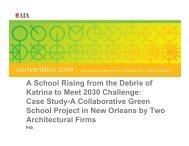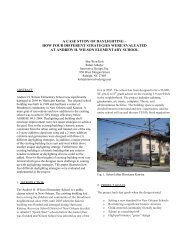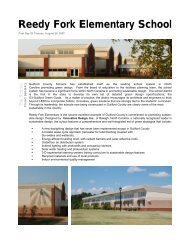SOLAR TODAY - May 2011 - Innovative Design
SOLAR TODAY - May 2011 - Innovative Design
SOLAR TODAY - May 2011 - Innovative Design
You also want an ePaper? Increase the reach of your titles
YUMPU automatically turns print PDFs into web optimized ePapers that Google loves.
the trade<br />
| hands-on news and information<br />
Best Practices<br />
The Quagmire of Electrical System Grounding<br />
The subject is complex. NEC Article 694 tries to clarify it.<br />
Mick Sagrillo (msagrillo@<br />
wizunwired.net) of<br />
Sagrillo Power & Light is<br />
a small-wind consultant<br />
and educator.<br />
By Mick Sagrillo with technical review by Roy Butler, Four Winds Renewable Energy<br />
As originally envisioned, grounding electrical systems<br />
in the United States was quite simple. Over the<br />
years, however, grounding has become increasingly<br />
complex and more confusing.<br />
The rules for grounding electrical equipment are laid<br />
out in Article 250 of the National Electrical Code (NEC).<br />
In addition, the new Article 694 on small wind turbines in<br />
the <strong>2011</strong> NEC covers a few of the differences unique to<br />
wind systems and clarifies a few additional considerations<br />
about grounding and lightning protection.<br />
Before delving into these, we need to differentiate<br />
between grounding for electrical faults and grounding for<br />
lightning protection.<br />
Lightning Protection<br />
Imagine this: It’s a cold, snowy Sunday morning, and,<br />
with a fire going in the woodstove, you head over to your<br />
favorite chair with cup of coffee in hand and the Sunday<br />
paper under your arm. But wait! That darned cat has<br />
already settled into your chair. Shuffling your feet on the<br />
carpet as you approach the chair, you stick your finger out<br />
toward the cat’s nose and ZAP! A spark flies and the cat<br />
flees. You have the chair all to yourself.<br />
What happened during the ZAP portion of this<br />
drama<br />
We all remember from grade school science the “experiment”<br />
where we rubbed rabbit fur on a piece of plastic and<br />
created some static electricity that we could discharge on<br />
the ear of an unsuspecting classmate. That same experiment<br />
was just conducted with your cat. Stocking feet on<br />
the carpet, dissimilar materials, static buildup: It’s got to<br />
equalize somehow. All you did was simply provide a discharge<br />
path through the cat’s nose.<br />
The same thing happens as the air masses roll across<br />
the planet: A static charge builds between ground and<br />
atmosphere, creating a giant capacitor (not unlike the<br />
capacitor in the flash on your camera). At some point,<br />
that static builds to a point where it has to discharge to<br />
equalize itself. This is what we call lightning, and it occurs<br />
several thousand times a minute at locations scattered<br />
around the planet.<br />
Understanding how to dissipate that static buildup<br />
between the atmosphere (with winds blowing across your<br />
wind turbine blades) and the earth (what your tower is<br />
attached to) will go a long way toward understanding how<br />
to minimize the attraction between lightning and your<br />
tower, and subsequent damage. By connecting wires from<br />
the tower structure to ground rods in the earth, you are<br />
able to dissipate the static charge that builds up on the<br />
tower and turbine, thereby making the tower less attractive<br />
to lightning strikes.<br />
In addition, should it strike, ground wires and rods give<br />
lightning a quick route to get from the tower to the earth.<br />
Although your tower is built on a concrete foundation<br />
embedded in the earth, the concrete is not necessarily a<br />
desirable path for lightning to get to the earth. Imagine<br />
the problem that would occur if lightning came down your<br />
tower and into the metal anchors embedded in the concrete.<br />
Depending on the conductivity and moisture content<br />
of the concrete, the lightning could shatter the foundation.<br />
However, the damage would remain completely<br />
unseen, buried below the ground, until a high wind event<br />
toppled the system over. Not good.<br />
Ground rods … dissipate the static<br />
charge that builds up on the tower<br />
and turbine … making the tower<br />
less attractive to lightning strikes.<br />
Equipment Grounding<br />
A second type of grounding, called bonding, includes<br />
connecting all metal components together electrically. This<br />
is required by the NEC so that no one component is isolated<br />
in such a way that it might carry a fault current that<br />
could harm someone. More importantly to a small wind<br />
system is the fact that bonding assures that all components<br />
of the system are at the same electrical potential should<br />
lightning strike and set up transient voltage on the wiring<br />
from the tower to the controls in the house. Equalizing<br />
such voltage potentials by bonding all metal components<br />
together will not eliminate lightning damage, but it often<br />
minimizes it.<br />
Grounding plays another role with wind systems. Just<br />
as with any electrical generating device, the metal components<br />
of a wind system need to be grounded to protect<br />
service personnel and the public from a shock caused by an<br />
electrical fault. Since alternators and wires carry an electrical<br />
current, and since they can short to the tower or wind<br />
turbine, it is prudent to make sure that this equipment is<br />
protected by proper grounding.<br />
Continued on page 76 ➢<br />
30 <strong>May</strong> <strong>2011</strong> <strong>SOLAR</strong> <strong>TODAY</strong> solartoday.org Copyright © <strong>2011</strong> by the American Solar Energy Society Inc. All rights reserved.









